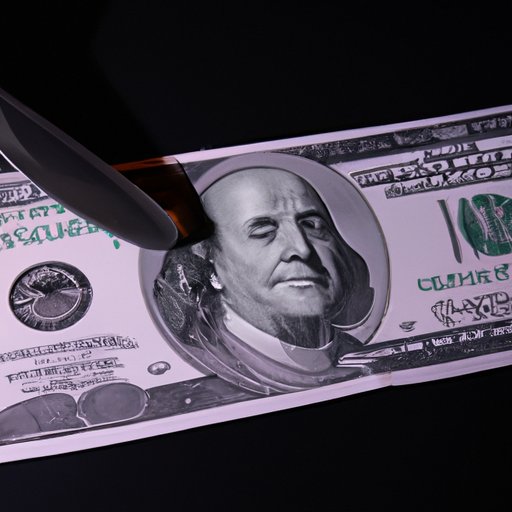
Introduction
Counterfeit money is a growing problem in today’s world, and businesses and individuals alike need to know how to detect it to protect themselves and their finances. Knowing how to spot counterfeit currency can mean the difference between losing money and making a profit, and it’s important to stay up to date on the latest methods and techniques in order to do so.
In this article, we’ll cover five simple ways to check for counterfeit money, as well as some more advanced tips, advice from experts in the field, and practical steps you can take if you find yourself in possession of fake currency.
5 Ways to Check for Counterfeit Money
One of the most effective ways to detect counterfeit money is to examine the currency closely. Here are five simple methods to help you do just that:
1. Examine the watermark
Hold the bill up to a light source and look for a faint image of the person whose portrait is featured on the front of the bill. If the watermark is missing or unclear, there’s a chance the bill is counterfeit.
2. Check the security thread
Bills have a thin strip running vertically through the left-hand side of the bill that bears the denomination of the currency and glows under black light. Hold the bill up to a light source to see if the strip is present and genuine.
3. Look for microprint
Many bills have tiny text on them that is difficult for counterfeiters to recreate. Use a magnifying glass to check for clear, sharp text around the portrait and elsewhere on the bill. If the text is blurry or smudged, this could indicate a fake bill.
4. Check the color-shifting ink
Many bills have ink that changes color depending on the angle from which it’s viewed. Hold the bill up to a light source and tilt it back and forth to see if the ink changes color. If it doesn’t, the bill could be counterfeit.
5. Check the feel of the paper
Real currency is made with a unique blend of materials that gives it a distinct feel. If a bill feels too stiff, too thin, or too slippery, it could be a fake.
Protecting Your Finances
In addition to the previous methods, there are several additional steps you can take to protect yourself from counterfeit money:
- Be wary of any offer that requires you to immediately exchange cash for goods or services – this is a common tactic used by counterfeiters to pass off fake bills as legitimate currency
- Be familiar with the security features of each denomination of currency, and keep an eye out for anything that looks different or out of place
- Consider investing in counterfeit detection equipment to make the process easier and more efficient
Don’t Get Scammed
Counterfeiters are constantly coming up with new ways to create fake currency, and it’s important to stay up to date on the latest methods and techniques they use in order to avoid being scammed. Some common tricks that counterfeiters use include:
- Washing out the ink on a lower-denomination bill and reprinting with a higher denomination
- Creating counterfeit coins using cheap metals or plated materials
- Using high-quality printers and scanners to create realistic-looking bills that can be difficult to detect
To minimize your risk of falling victim to a counterfeiting scheme, make sure to stay vigilant and use the tips and methods outlined in this article to keep your finances safe.
Counterfeit Money: What to Do With It
Although it can be frustrating to discover that you’ve received counterfeit money, there are steps you can take to minimize the damage and protect yourself:
- Don’t try to use the counterfeit currency – this is a crime and could land you in legal trouble
- Contact the local police department or the US Secret Service to report the counterfeit bill and provide them with any information you have about where and when you received it
- Keep the counterfeit currency as evidence in case you need to present it to the authorities later on
The Ultimate Guide to Detecting Fake Money
There are many techniques and methods for detecting counterfeit currency, and the key to staying safe is to stay informed and up to date on the latest tips and tricks. Here are some additional tips from professionals in the law enforcement and finance industries:
- Train yourself and your employees to recognize the security features of each denomination of currency, and make checking for counterfeit bills a routine part of your business practices
- Stay up to date on common counterfeiting techniques and methods by attending seminars or training sessions
- Use advanced counterfeit detection tools such as counterfeit detection pens or ultraviolet light to help you quickly and easily identify fake bills
Conclusion
Counterfeit money is a serious problem, but with the right tools and knowledge, you can protect yourself and your business from falling victim to counterfeiting schemes. Stay vigilant, stay informed, and use the methods and techniques outlined in this article to keep yourself and your finances safe.
For more information or additional resources, visit the US Secret Service or your local law enforcement agency.




